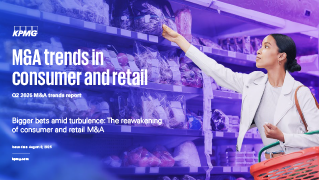Defensive M&A and asset selectivity shape Q3
Despite persistent macroeconomic and geopolitical headwinds, third-quarter 2025 (Q3’25) consumer and retail merger and acquisition (M&A) activity was defined by a clear split: premium, category-defining assets drew strong bids and high valuations, while middling assets faced muted interest and execution risk. This selectivity reflects a defensive posture, with many deals driven by the need to generate cash, streamline portfolios, and refocus on core operations. At the same time, buyers are actively pursuing opportunities to capitalize on emerging trends, strengthen established portfolios with fresh brands, and enter new categories.
Lowe’s acquisition of Foundation Building Materials targeted pro-customer expansion,1 Atlas Holdings’ purchase of The ODP Corporation was a sponsor-led restructuring play,2 and the Keurig Dr Pepper/JDE Peet’s reorganization3 reflected ownership shifts and portfolio realignment. Each major transaction was shaped by distinct strategic imperatives, ranging from operational focus and defensive repositioning on the sell side, to buy-side strategies such as capitalizing on emerging trends, strengthening established portfolios with fresh brands, and entering new categories.
Sector fundamentals remained pressured by profit margin compression, as inflation, tariffs, and volatile input costs continued to weigh on profitability. With consumers balking at further list‑price moves—and some categories reportedly declining year‑over‑year (YoY)—operators are emphasizing cost discipline over pricing to protect margins. Companies’ ability to offset these pressures through additional pricing actions was constrained by consumer price sensitivity. As a result, most management teams prioritized cost takeout and operational resilience, given that top‑line growth remained elusive and sector stocks underperformed. Meanwhile, K‑shaped consumer demand—high‑income consumers maintaining spending or trading up, lower‑income groups shifting to private label—forced organizations to rethink mix, margin, and strategic priorities.
Private equity activity focused on operational transformation, brand repositioning, and scenario planning for recession risk and exit timing. The industry’s resilience was evident in the rebound in deal value, but the market remains bifurcated and cautious, rewarding strategic clarity and readiness over scale.























